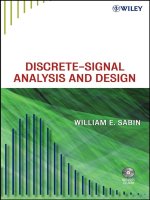DISCRETE-SIGNAL ANALYSIS AND DESIGN- P21 pps
Bạn đang xem bản rút gọn của tài liệu. Xem và tải ngay bản đầy đủ của tài liệu tại đây (154.73 KB, 5 trang )
86 DISCRETE-SIGNAL ANALYSIS AND DESIGN
and h(m) must provide an initial separation of at least one (m). If we need
to reduce L in order to reduce the sequence length, the method of circular
convolution can be used, as illustrated in Fig. 5-5. Note that the amplitude
scales and the number of samples for x (m)andh(m) can be different. The
following steps are executed.
(a) x(m) is plotted.
(b) h(m) is plotted.
(c) h(m)isßipped about the m =0 point on the m-axis. The h(m) line
at m =+2 (length equals zero) now appears at m =−2, which is
the same as m =−2 +16 =+14. The line that was at m =+11
(length 9) now appears at m =−11, which is the same as m =−11
+16 =+5.
(d) We do not start the sum of products (convolution) of overlapping
x(m)andh( −m) at this time.
(e) The h( −m) sequence advances 2 places to h(2 −m). The line at
m =14 (length zero) moves to m =
16, which is identical to m =0.
The h(n −m)andx(m) sequences are now starting to intersect at
m =0.
(f) The process of multiply, add, and shift begins. The result for
(11 −m) is shown for which the convolution value is 224. For
values greater than (18 −m) the convolution value is 0 because x
and h no longer intersect.
As we can see, this procedure is confusing when done manually (we
do not automate it in this book), and it is suggested that the side-by-side
method of Figs. 5-3 and 5-4 be used instead. Adjust the length L =[x(m) +
h(m) +1] as needed by increasing N ( =2
M
), and let the computer perform
Eq. (5-4), the simple sum of products of the overlapping x (m)andh(m)
amplitudes. The lines of zero amplitude are taken care of automatically.
Design the problem to simplify the process within a reasonable length L.
Time and Phase Shift
In Fig. 5-6 a sequence x(m) is shown. A single h(3) is also shown and
h(−3) is the ßip from +3to−3. The amplitude of h(m) is 2.0. If we
now suddenly move h(−3) forward six places to become h(6 −3) for an
n =6, we get y (3), which is a copy of x(6 −3), shifted to the right three
MULTIPLICATION AND CONVOLUTION 87
0
0
0
0
0
0
1
1
1
1
1
2
2
2
2
2
3
3
3
3
3
4
4
4
4
4
5
5
5
5
5
6
6
6
6
6
7
7
7
7
7
8
8
8
8
8
0
0
0
0
0
5
5
5
5
16
10
10
10
10
m
m
m
m
m
10
10
10
10
10
11
11
11
11
11
12
12
12
12
12
13
13
13
13
13
14
14
14
14
14
15
15
15
15
15
16
16
16
16
16
2
0
0
0
0
2
2
2
2
1
1
1
1
3
3
3
3
4
4
4
4
5
5
5
5
4
6
8
6
6
6
6
10
7
7
7
7
12
8
8
8
8
14
9
9
9
9
x(m)
h(m)
h(−m)
h(−m + 2)
h(−m + 11)
9
9
9
9
9
8
(a)
(b)
(c)
(d,e)
(
f
)
9 x 0 + 8 x 2 + 7 x 4 +
6 x 6 + 8 x 5 + 4 x 10
+
3 x 12 + 2 x 14
=224
m = 0
Figure 5-5 Circular discrete convolution.
88 DISCRETE-SIGNAL ANALYSIS AND DESIGN
−10 −50 5 1015
0
5
10
x(m)
−10 −50 51015
0
10
y(n)
y(3)
n
−10 −50 51015
0
1
2
h(m)
h(3)
h(−3)
m
m
Figure 5-6 Time-shift property of a discrete sequence.
places and ampliÞed by a gain factor of 2. The x (m) sequence has been
suddenly moved forward (advanced) in time by three units, to become
y(3) =x(m +3). If x (m) is 360
◦
of a periodic sequence, its phase has
been advanced (forwarded) by 360·3/5 =216
◦
.Ify(n) is the un-shifted
sequence, the shifted sequence y(n +u)is
y(n + u) = y(n) e
j2π(u/N)
= y(n)
cos
2π
u
N
+ j sin
2π
u
N
(5-5)
where the positive sign of the exponential indicates a positive (counter-
clockwise) phase rotation and also a positive time advance as deÞned in
Chapter 1 and Fig. 1-5. In other words, y(n) has suddenly been advanced
forward three time units.
We can more easily go directly from x(m)toy(n) by just advanc-
ing x(m) three places to the right, which according to Eq. (5-5 ) is the
time-advance principle (or property) applied to a discrete sequence.
MULTIPLICATION AND CONVOLUTION 89
DFT and IDFT of Discrete Convolution
If we take the discrete convolution of Eq. (5-4) and apply the DFT of Eq.
(1-2), we can get two useful results. The Þrst is that the discrete convo-
lution y(m) =x(m) ∗ h(m) in the time-domain transforms via the DFT
to the discrete multiplication Y (k) =X (k)H (k) in the frequency domain
in the manner of the sequence multiplication of Eq. (5-1). That is, Y (k)
is the “output” of X (k)H (k ) at each k.IfX (k ) is the voltage or current
spectrum of an input signal and H (k) is the voltage or current frequency
response of a linear Þlter or linear ampliÞer, for example, then Y (k)is
the voltage or current spectrum of the output of the linear system.
The second result is that the IDFT [see Eq. (1-8)] of the discrete convo-
lution Y (k) =X (k) ∗ H (k ) produces the discrete product y(n) =x(n)h(n).
This type of convolution is often used, and one common example is fre-
quency translation, where a baseband signal with a certain spectrum is
convolved with an RF signal that has a certain RF spectrum to produce
an output RF spectrum Y (k). The IDFT of Y (k)isy(n), the time-domain
output of the system, which is often of great interest.
It is interesting to see how the DFT of convolution in the time domain
leads to the product in the frequency domain. We start with the double
summation in Eq. (5-6), which is the DFT [Eq. (1-2)] of the discrete
convolution [Eq. (5-4)].
Y(k) =
1
N
N−1
n=0
+∞
m=−∞
x(m)h(n − m)
convolution
e
−j 2πk(n/N)
DFT
(5-6)
We will modify this, with no resulting error, so that the limits on
both summations extend over an inÞnite region of n and m, with unused
locations set equal to 0, and with n and m interchanged in the summation
symbols.
Y(k)=
1
N
m=+∞
m=−∞
n=+∞
n=−∞
x(m)h(n − m)
e
−j 2πk(n/N)
(5-7)
90 DISCRETE-SIGNAL ANALYSIS AND DESIGN
Since x(m) is not a function of n, it can be associated with the Þrst
summation (again with no error) and the exponential term is associated
only with n.
Y(k) =
1
N
m=+∞
m=−∞
x(m)
n=+∞
n=−∞
h(n −m)e
−j 2πk(n/N)
(5-8)
We now apply the well-known time delay theorem of the Fourier
transform to the second summation in brackets [Carlson, 1986, pp. 52
and 655; Schwartz, 1980, pp.72– 73]. The DFT of this expression is
DFT of h(n −m) = H(k)e
−j 2πk(m/N)
(5-9)
and Eq. (5-8) can be rewritten as
Y(k) =
1
N
m=+∞
m=−∞
x(m)H(k)e
−j 2πk(m/N)
=
1
N
m=+∞
m=−∞
x(m)e
−j 2πk(m/N)
=X(k)
H(k) (5-10)
=X(k)H(k)
The same kind of reasoning veriÞes that the IDFT of Y (k) =X (k) ∗
H (k) and leads to y(n) =x (n)h(n). These kinds of manipulations of sums
(and integrals) are often used and must be done correctly. The references
at the end of this chapter accomplish this for this application.
Figure 5-7 illustrates the general ideas for this topic, which we discuss
as a set of steps (a) to (h), and also conÞrms Eq. (5-10):
(a) This is x (m), a nine point rectangular time-domain sequence.
(b) This is h(m), a 32-point time-domain sequence with an exponential
decay.









